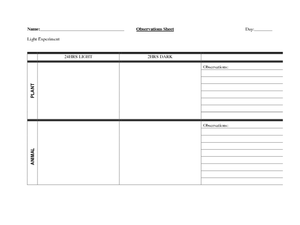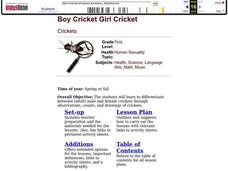Curated OER
Alternative Animal Agriculture
Presenting an unusual topic, this collection of slides examines alternative animals that can be grown for profit or human use. It details the raising of rabbits as food, llamas for textiles, earthworms as fish bait, and a variety of...
Curated OER
Hopper Circus
Students explore biology by participating in an insect identification activity. In this grasshopper lesson, students discuss the types of insects who jump high and identify their anatomical parts. Students collect a group of "hopper"...
Curated OER
The Effect of Temperature on Cricket Chirping
Students examine the effect of temperature on how often crickets chirp. In groups, they complete the experiment and answer lab discussion questions. They create a graph of temperatures and the amount of chirps and discuss the results.
Curated OER
A Home for a Cricket
First graders build a habitat for crickets after studying animal survival needs. They care for and observe the crickets in the classroom habitat.
Curated OER
The Crickets in the Classroom Page
Learners observe crickets to practice observation, measurement and hypothesis skills. In this cricket lesson, students observe crickets mating, producing a calling song, and being territorial.
Curated OER
Cricket Wars
Students investigate crickets in their habitat. In this insect lesson, students create a cricket habitat by using a glass jar with grass clippings and cloth. Students observe how crickets interact with each other and their eating habits.
Curated OER
Cricket Weather
In this collecting data learning exercise, 4th graders use the data collected on crickets chirps and the temperature to make a line graph by following 4 directives.
Curated OER
Dissecting Crickets
Students dissect a cricket and note the three body regions, wings, and legs. They observe the yellow malphigian tubes and remove them. They dissect the esophagus and analyze the heart for respiratory rates and heart beat rates.
Curated OER
We Are All In This Together
Third graders observe four different arthropods.Students find, observe, discuss and record similarities and differences among and between insects and people. They appreciate diversity in and recognize unity of all people.
Curated OER
Investigating Crickets and Their Body Parts
Second graders investigate the body of a cricket. In this biology lesson students use tools to gain information about the insect the cricket. Students observe and identify features and describe how these features help the cricket live in...
Curated OER
Boy Cricket Girl Cricket
Students investigate crickets. In this series of cricket activities, students observe and chart crickets. Students discuss the differences between male and female crickets, record findings in a journal, handle crickets, and read a...
Curated OER
Anthropods and Echinoderms
Students examine the attributes of crickets. In this arthropods instructional activity, students observe crickets and sketch and label their parts. Students respond to questions regarding their observations.
Curated OER
Mini-Ecosystems
Third graders identify the living and non living things in a book read aloud and discuss the interactions represented in the book. Then, they research and include a list of food that each animal needs in an ecosystem. Finally, 3rd...
Curated OER
Exploring Literature And Weather Through Chirps
Students explore using crickets' chirps to calculate temperature. They read "Cricket in Times Square" and "The Quiet Cricket," read and discuss a Cricket eBook, develop a formula and calculate temperature using cricket chirps, and graph...
Curated OER
Territorial Behavior in Crickets
Students explore the behavior of crickets during courtship. They measure the number and types of interactions between household crickets. Students discriminate between quantitative and qualitative observations. They collect data to...
Curated OER
Cricket Wars
Third graders explore living and nonliving things in a garden environment. In this garden environment lesson, 3rd graders study the effects of crickets in a garden. Students explore the interaction between living and nonliving elements.
Curated OER
Organisms – Their Needs
Students compare and contrast different organisms characteristics. In this life science lesson, students design an experiment about plants and animals needs. They collect data and write their conclusion about the experiment.
Curated OER
Crickets on the Hearth
Students investigate how crickets behave in cold temperatures. In this life science lesson, students explain the beneficial and harmful effect of pests. They research ways to properly manage them.
Curated OER
Head, Shoulders, Knees & Toes
Students, through observation of crickets, recognize and use proper names for human and insect body parts. They compare and contrast parts of human and insect body parts.
Curated OER
Boy Cricket Girl Cricket
First graders differentiate between (adult) male and female crickets through observations, counts, and drawings of crickets.





















